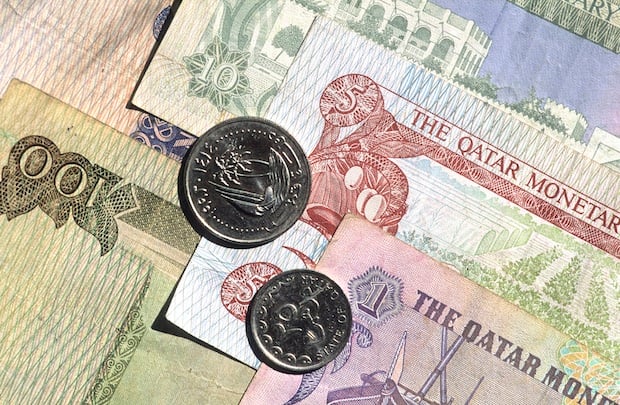Qatar riyal FX market in chaos as GCC diplomatic row continues
Bankers in the region believe the riyal’s peg to the dollar remains solid

Economic sanctions and poor liquidity have created chaos in the foreign exchange market for Qatari riyals, with the currency trading far below its peg to the US dollar this week, but bankers in the region believe the peg remains solid.
The riyal has been increasingly volatile in the spot market since Saudi Arabia, the United Arab Emirates, Bahrain and Egypt cut diplomatic and transport ties with Qatar on June 5, accusing it of backing terrorism.
Some banks are quoting huge bid-ask spreads, there are big jumps in quoted rates within the space of a few minutes, some customers find it difficult to fill orders because of poor liquidity, and there’s continual uncertainty about which banks are still willing to trade riyal and in what volumes.
At times, the riyal has been quoted by Qatari banks very near its peg of 3.64 to the dollar; at other times, foreign banks have quoted it much lower. This week it traded between banks as low as 3.81, more than 4 percent below its peg – the lowest level this decade.
Normally, such a gap would suggest the central bank was abandoning the peg and allowing its currency to depreciate but this time the riyal’s drop is due to the way the diplomatic crisis has fragmented the foreign exchange market.
Many Gulf banks have suspended or reduced ties with Qatar, causing funds in the market to flow more slowly and inefficiently between onshore and offshore banks.
This has opened a chasm between onshore trade, where the Qatari central bank has continued to provide ample supplies of dollars at a rate of up to 3.6415 under its peg mechanism, and offshore trade, where jittery foreign banks are demanding a premium for buying riyals, pushing the currency lower.
“There’s definitely an arbitrage between offshore and onshore rates because of the uncertainty, and traders are taking advantage of the volatility,” said a senior treasury official at a bank in Abu Dhabi.
But the official, who like others in the region declined to be named because of political sensitivities, said there was no reason to think Qatar would need to take the risky and destabilising step of abandoning its peg.
“Qatar Central Bank will definitely defend the peg… It makes no sense for Qatar to de-peg. It won’t happen from an economic point of view. If it de-pegs at all, that would be due to political reasons.”
The riyal’s lowest levels were hit early this week when all Gulf Arab financial markets were closed for the Eid al-Fitr holidays, leaving offshore banks in Europe and New York to trade without reference to business in the Gulf.
On Wednesday morning, when the UAE and Bahrain reopened after the holidays, an Abu Dhabi bank quoted the riyal only slightly below the peg at 3.6550. Qatar itself will remain on holiday throughout this week and reopen next Sunday.
CENTRAL BANK
Qatar’s central bank had net foreign reserves of $34.8bn in May and Doha is estimated to have over $200bn of liquid assets in its sovereign wealth fund – enough to defend the peg for years, even if there is a mass withdrawal of foreign bank deposits from Qatar, analysts calculate.
That raises the question of why the central bank has not intervened aggressively by flooding the market with dollars to keep riyal spot rates consistently in line with the peg and deter offshore speculation.
Ehsan Khoman, regional strategist at Bank of Tokyo- Mitsubishi UFJ, said such action was possible if the gap between onshore and offshore rates continued to widen.
“It would not be unprecedented if the Qatar Central Bank intervenes in some form in the offshore market to inject USD liquidity, which would narrow the divergence somewhat precipitously.”
Several commercial bankers in the region, however, said they thought the central bank simply saw no need to spend part of its reserves getting drawn into a battle with offshore banks.
Forwards market prices show that expectations for long-term riyal depreciation are minor and not enough to trigger major capital flight from Qatar.
The country gets most of its dollar supplies from oil and gas exports, which are controlled by the government, so it does not need to fear offshore trade will suck dollars away from onshore companies which need them.
In this situation, the central bank may see no harm in an offshore weakening of the riyal, especially if it means foreign banks considering whether to sell their riyal assets would face an exchange loss in doing so, the bankers said.
In his only public statement since the diplomatic crisis erupted, central bank governor Sheikh Abdullah bin Saud al-Thani said Doha had enough foreign currency reserves to meet all its requirements, but did not explicitly mention the peg.
The central bank has privately told Qatari banks, however, that it is committed to the peg, a Qatari commercial banker told Reuters.
“The message was that those hedge funds and other international investors who bet against the peg will lose their money.”
